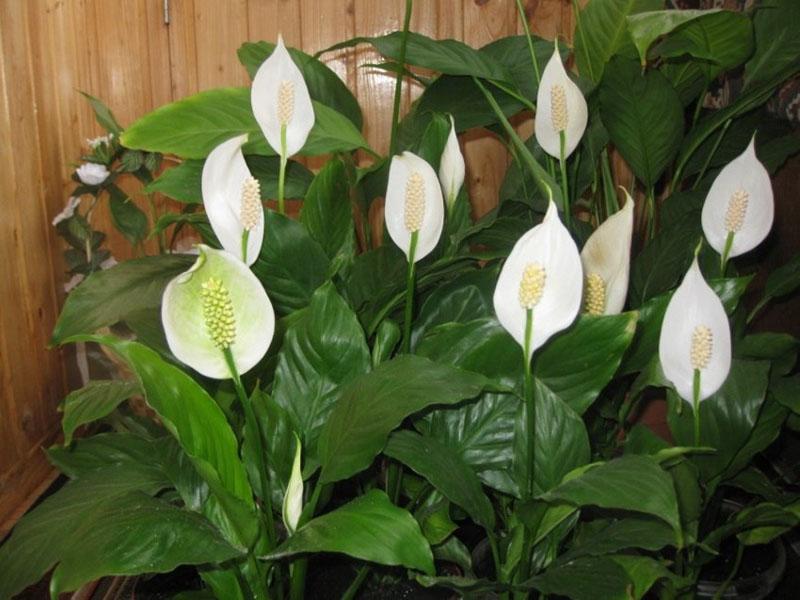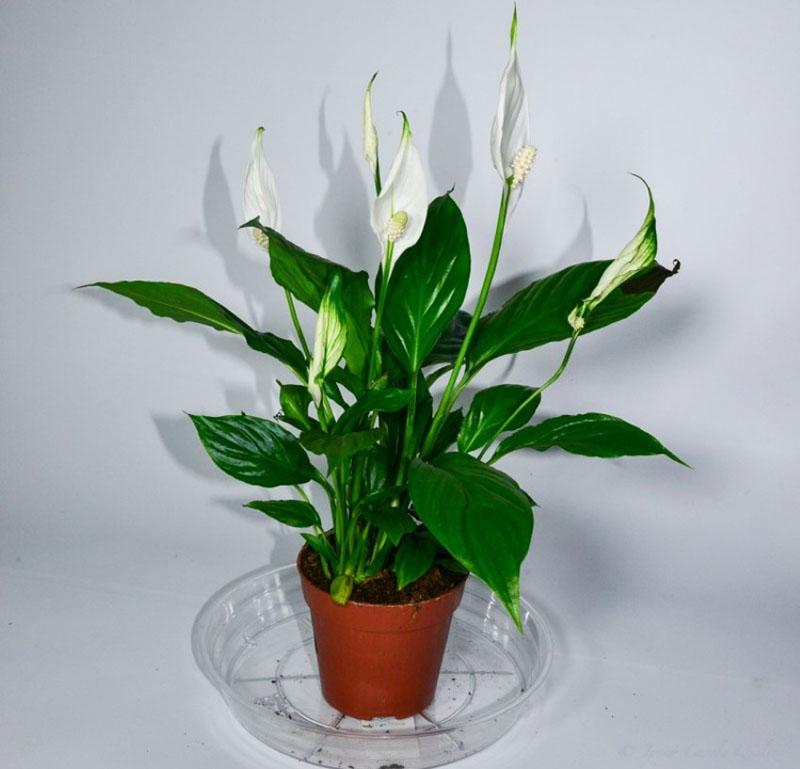Spathiphyllum - leaving from A to Z for home "female happiness"
 If you want to make a "live", but not burdensome gift to a loved one, hand him spathiphyllum, the care of which is so simple that even novice flower growers can do it. Originally from the warm tropics, this culture does well in indoor conditions. And in gratitude for the life-giving moisture, it will give a gentle flowering. Unusual inflorescences with pristine white veils rise above a dense green rosette, like fancy sails. And they do not fade for a long time, but even without them a dense bush looks very decorative. It is unpretentious, not picky about lighting and frequent transplants. What is this handsome man and how can you pamper him?
If you want to make a "live", but not burdensome gift to a loved one, hand him spathiphyllum, the care of which is so simple that even novice flower growers can do it. Originally from the warm tropics, this culture does well in indoor conditions. And in gratitude for the life-giving moisture, it will give a gentle flowering. Unusual inflorescences with pristine white veils rise above a dense green rosette, like fancy sails. And they do not fade for a long time, but even without them a dense bush looks very decorative. It is unpretentious, not picky about lighting and frequent transplants. What is this handsome man and how can you pamper him?
Botanical characteristic

Spathiphyllum has no stem. Its leaves grow directly from the shortened rhizome and gather in a dense rosette. Its average height is about 40 cm, but there are also real giants up to 1 m in height. First, a petiole appears, which eventually stretches and lends to the top, on which a beautiful leaf unfolds. The leaf plate has an oval shape and a pointed tip. It has a pronounced central vein, from which slightly depressed lateral veins diverge. They give the leaf a slightly wrinkled structure, while it is quite dense to the touch.
Spathiphyllum grows quickly and in just a season its rosette becomes twice as thick due to young leaves. He also willingly gives root processes with which the flower can be propagated.
At the end of spring, tall peduncles begin to form from the axils of the leaves, thin, but very strong. The flower itself is a long ear, wrapped in a white blanket. It consists of small, male and female, flowers, tightly pressed against each other. Each flower lasts up to 10 weeks, then the veil turns green and dies off. Usually, by mid-autumn, flowering ends, and the bush goes to rest, while not shedding foliage.
Cases of winter flowering of spathiphyllum are also frequent. This is facilitated by the increased humidity. But home plants do not tie seeds. To do this, they must be pollinated by bees, and even then a special "breed", which is only in the tropics.
Spathiphyllum - care in terms of creating optimal conditions of detention
 This herbaceous bush does not impose any special requirements and will survive even with a lack of lighting. However, to see its bloom, it is worth choosing the right location for the pot. However, this is not as difficult as it seems.
This herbaceous bush does not impose any special requirements and will survive even with a lack of lighting. However, to see its bloom, it is worth choosing the right location for the pot. However, this is not as difficult as it seems.
Remember three basic rules:
- diffused light;
- high air humidity;
- warmth in summer and, if possible, light coolness during rest.
Now let's dwell on each point in more detail.
Spathiphyllum is popularly called “female happiness” and is considered a symbol of well-being in family life.
Lighting
 As a flowering crop, Spathiphyllum needs enough sun to bloom. But, although its foliage has a dense structure, even it can suffer from scorching direct rays. Therefore, the southern window will be an excellent option if there are blinds that will "break" the rays in the right direction.Alternatively, use another option to make the lighting diffuse, such as a lightweight tulle curtain. With this kind of lighting, the bush will be thicker, and the flowering will be larger and longer.
As a flowering crop, Spathiphyllum needs enough sun to bloom. But, although its foliage has a dense structure, even it can suffer from scorching direct rays. Therefore, the southern window will be an excellent option if there are blinds that will "break" the rays in the right direction.Alternatively, use another option to make the lighting diffuse, such as a lightweight tulle curtain. With this kind of lighting, the bush will be thicker, and the flowering will be larger and longer.
If your windows face the shaded side, this is not a disaster either. The flower can grow in partial shade. It's just that its leaves will slightly stretch and darken, and flowering will be rare.
Air humidity
 In its homeland, in the tropics, spathiphyllum receives moisture not only from the roots, but also from the air. In our houses and apartments, of course, it will not work to recreate the ideal tropics. But it is quite possible to maintain the humidity of the air necessary for the flower at least 60%. First of all, spray the bush more often, and in the summer - "bathe" in the shower. At the same time, protect the white sail-blankets from water drops. Dark spots appear from them, spoiling all this beauty.
In its homeland, in the tropics, spathiphyllum receives moisture not only from the roots, but also from the air. In our houses and apartments, of course, it will not work to recreate the ideal tropics. But it is quite possible to maintain the humidity of the air necessary for the flower at least 60%. First of all, spray the bush more often, and in the summer - "bathe" in the shower. At the same time, protect the white sail-blankets from water drops. Dark spots appear from them, spoiling all this beauty.
Pour wet pebbles into the pallet and keep it that way. The pot placed on top will "breathe" the fumes from the pebbles.
Room temperature
 Usually in apartments and houses about 20 ° C heat and this spathiphyllum is quite enough. In summer, it will withstand a slight heat up to plus 27 ° C, but on condition that it is humid. But after the end of flowering, the degrees can be reduced. The period of relative rest usually falls in the autumn-winter season. At this time, growth processes are practically "at zero" and 18 ° C will be enough for the plant.
Usually in apartments and houses about 20 ° C heat and this spathiphyllum is quite enough. In summer, it will withstand a slight heat up to plus 27 ° C, but on condition that it is humid. But after the end of flowering, the degrees can be reduced. The period of relative rest usually falls in the autumn-winter season. At this time, growth processes are practically "at zero" and 18 ° C will be enough for the plant.
Do not leave the flower in a cold room or in drafts. At 13-10 ° C heat, the risk of developing putrefactive processes increases. This can lead to the complete death of the plant.
Spathiphyllum - home care as the secret of growing success
 Lover of moisture, the flower needs loose soil, which allows it to pass well and saturates the roots with oxygen. In this case, the soil should be nutritious, given the strength of growth and abundant flowering of the rosette. In flower shops there are ready-made soil mixtures for spathiphyllum from different manufacturers.
Lover of moisture, the flower needs loose soil, which allows it to pass well and saturates the roots with oxygen. In this case, the soil should be nutritious, given the strength of growth and abundant flowering of the rosette. In flower shops there are ready-made soil mixtures for spathiphyllum from different manufacturers.
If you prefer to cook the substrate yourself, just mix equal parts:
- peat;
- humus;
- leafy land;
- sand.
Add to the resulting mixture 2 shares of turf soil and some brick chips. And for the prevention of root rotting - charcoal.
Watering frequency
 Spathiphyllum has a special relationship with water - he loves it very much, but at the same time does not tolerate excess. The soil in the pot should be moist at all times. It should not be allowed to dry out completely. Then not only the leaves that lose their turgor suffer, but the roots that begin to dry out. And although after the restoration of watering, the leaves tend to rise again, they often turn yellow and dry too.
Spathiphyllum has a special relationship with water - he loves it very much, but at the same time does not tolerate excess. The soil in the pot should be moist at all times. It should not be allowed to dry out completely. Then not only the leaves that lose their turgor suffer, but the roots that begin to dry out. And although after the restoration of watering, the leaves tend to rise again, they often turn yellow and dry too.
In the summer, water the flower up to 3 times a week, monitoring the condition of the earth. But in winter, one watering per week will be enough. Of course, if the room is not hot.
After the procedure, make sure that no water remains in the pan. Be sure to drain all the excess that has dripped, otherwise the roots will rot.
Top dressing - what and how often
In order to form a dense rosette and flower stalks, the spathiphyllum needs nutrients. He loves both organic and mineral preparations. Most of all, the bush needs additional nutrition during the period of active growth and flowering. From early spring to early fall, feed it every 2 weeks. In winter, a single application of fertilizers every month will be enough for the plant.
If your bush has bloomed in winter, do not reduce its "diet" and feed it twice a month.
For fertilizing spathiphyllum, preparations for ornamental or flowering plants are suitable (depending on the feeding phase). You can use fertilizers of the following brands:
- Agricola;

- Forte;

- Pocon;

- Florovit.

When to transplant
 Young bushes grow in small pots, and quite quickly. They will have to be replanted annually, changing the container to a more spacious one. Adult plants can live in one flowerpot for up to 5 years. At the same time, whether or not a transplant is needed should be decided only after examination and analysis of the "behavior" of the spathiphyllum.If a lush large bush has stopped blooming, but outwardly is absolutely healthy, it means that it is cramped. This is confirmed by the large number of young rosettes in the pot.
Young bushes grow in small pots, and quite quickly. They will have to be replanted annually, changing the container to a more spacious one. Adult plants can live in one flowerpot for up to 5 years. At the same time, whether or not a transplant is needed should be decided only after examination and analysis of the "behavior" of the spathiphyllum.If a lush large bush has stopped blooming, but outwardly is absolutely healthy, it means that it is cramped. This is confirmed by the large number of young rosettes in the pot.
Do not plant a flower immediately in a large pot, with a margin. In this case, there will also be no flowering until the roots completely fill the flowerpot.
It is better to transplant spathiphyllum by transshipment, slightly freeing it from the old soil. By the way, the transplant can be combined with reproduction. At home, the bush reproduces only by division. Just divide the rhizome into sections, so that each has a leaf rosette and roots. If it so happens that there are no roots, it doesn't matter. Place the cut in water, and it will build up them, and then root it in the ground.
Do I need to trim
Spathiphyllum does not need forming pruning, because it does not have a stem, the development of which can be regulated. It is enough after flowering to remove faded peduncles and dead leaves, if any.
Spathiphyllum - care and possible problems
 Even the most unpretentious plants can sometimes suffer from care errors, diseases or pests. Spathiphyllum is no exception. Most often, the reason for the deterioration of the condition of the flower is inappropriate conditions of detention or improper watering.
Even the most unpretentious plants can sometimes suffer from care errors, diseases or pests. Spathiphyllum is no exception. Most often, the reason for the deterioration of the condition of the flower is inappropriate conditions of detention or improper watering.
When growing, you may encounter such situations:
- The tips darken on the leaves - the air is too dry. Increase the humidity by spraying the bush and adding damp pebbles to the pan.
- The tips of the leaves turned yellow - hard water for irrigation. Use standing rainwater.
- The leaves curl and sag - the room has become cold. Move the pot to a warmer area.
- Foliage wilted - excess moisture in the soil or it is dry. Depending on the reason, let the soil dry or water the flower.

- Roots rotted - from waterlogging. Transplant the plant urgently by changing the soil. Cut off all affected parts. Process fungicide to prevent further development of rot.
- The color of the leaves has become pale - the plant has too much light. Shade the window or rearrange the flowerpot.
- Leaves rot - the room is damp and cold. Adjust conditions of detention, cut diseased fragments.
- The bush grows slowly - there is not enough nutrients in the soil or it is “clogged” and becomes dense. Feed or transplant the plant.
- Flowering does not occur. There may be several reasons: not enough light, dry air, lack of nutrients. Also, spathiphyllum does not bloom if it is too thick and has not been transplanted for a long time.
Sometimes droplets can be seen at the tips of the leaves. They pose no threat. Simply, in this way, spathiphyllum gets rid of excess moisture. Almost all members of the aroid family react in the same way.
Summing up, it can be noted that there is nothing complicated in how to care for spathiphyllum. Do not forget to water your pet, periodically feed and spray the bush. And then it will always be lush and beautiful, and also delight with charming flowering.
Hello. What can be with a flower? The fact is that the humidity in our apartment is 60%, so, apparently, this is not the reason ...
Most likely, it is rotting. Examine the roots, cut off the damaged ones, treat with a fungicide. These scary leaves need to be cut off and the flower planted in new soil. Do not place the flowerpot in drafts, as the leaves begin to disappear from them. Do not fill - he does not like it.
Second photo…
Thank you so much!
Hello! The leaves of our flower sank, as if it needed to be watered, the leaves wilted as if ... watering abundantly did not help, they took it out of the pot and put it in the water, it rose ... and now they transplanted it again and the leaves sank again, water it, but the leaves do not rise. Tell me what to do
Have you looked at the roots? This happens when they rot and are unable to provide the bush with moisture. The leaves can also droop if the flower is frozen or damaged by a draft.
In your article there is a picture with dropped leaves, number 1 ... I can't upload a photo
The roots seem to be good, white ... tell me what to do then if he suffered from a draft? Again, when in a jar of water, the leaves rise, stand, and in the pot they fall again (
I have not come across this, but I looked a little and found information that after transplanting the flower can hurt for a long time and adapt, including lowering the leaves. And in order to help it take root faster, it is advised to treat it with "anti-stress drugs" such as Zircon or Fitosporin. Try it, it should help. In any case, you should not drag the bush back and forth, as it will definitely lose the chance to survive.
Thank you so much!
Good evening, gave us a spatik, can you put it in the water or leave it until morning ??
I have a flower that lives for 2 years and almost does not bloom, for the whole time it bloomed 3 times and one flower at a time, well, the leaves are good and the flower is big, tell me what to do
Spathiphyllum does not bloom if it has too large a pot or a deep root collar. Even in winter, he needs good lighting and warmth. Try fertilizing to stimulate flowering.
My pot is on a stand opposite the southern window, it does not grow very quickly and willingly, only a few leaves per year, but it blooms annually and without additional fertilizing.